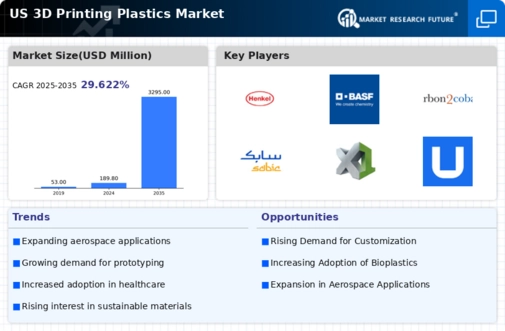The US 3D Printing Plastics Market is characterized by rapid technological advancements and a dynamic competitive landscape, reflecting the profound impacts of innovation on manufacturing methodologies. As industries recognize the vast potential of 3D printing, the demand for high-quality plastics specifically designed for additive manufacturing has surged.
Market players are focused on developing advanced materials that deliver not only enhanced performance but also meet industry-specific requirements. The competitive insights within this market reveal an ongoing trend towards collaboration and partnerships, as companies aim to harness diverse expertise in materials science and engineering to provide better solutions.
The landscape is shaped by a blend of established firms and emerging companies, each vying for market share through product differentiation and technological advancements.Henkel stands out in the US 3D Printing Plastics Market with its extensive portfolio and commitment to innovation.
Known for delivering high-performance materials, Henkel's strength lies in its robust research and development capabilities, which allow it to create specialized resins that cater to various sectors, including automotive, aerospace, and consumer goods. The company's value proposition is bolstered by its strong customer relationships, enabling it to understand market needs and respond quickly with tailored solutions.
Furthermore, Henkel places a significant emphasis on sustainability, which is increasingly becoming a priority for customers in today's environmentally conscious landscape. By integrating sustainable practices into its product offerings and operational strategies, Henkel not only enhances its market presence but also strengthens brand loyalty and customer trust within the US 3D printing sector.
BASF
BASF is a formidable player in the US 3D Printing Plastics Market, backed by a comprehensive range of key products and services aimed at various printing technologies. The company is recognized for its innovative filament solutions, including high-quality thermoplastics designed for FDM and SLA processes, which are essential for achieving superior printing results.
BASF's market presence is further enhanced by its strategic investments in research and development, positioning it at the forefront of emerging trends in 3D printing technology. In addition to its product offerings, BASF has engaged in significant mergers and acquisitions to augment its capabilities, as they seek to expand their market reach and capabilities within the US.
This approach not only highlights the company's aggressive stance towards growth but also enhances its ability to deliver new solutions that meet the evolving demands of the additive manufacturing landscape.
Overall, BASF's commitment to innovation, coupled with its strong operational foundation, allows it to remain a vital competitor in the US 3D Printing Plastics Market.





















Leave a Comment